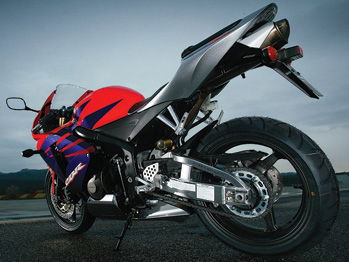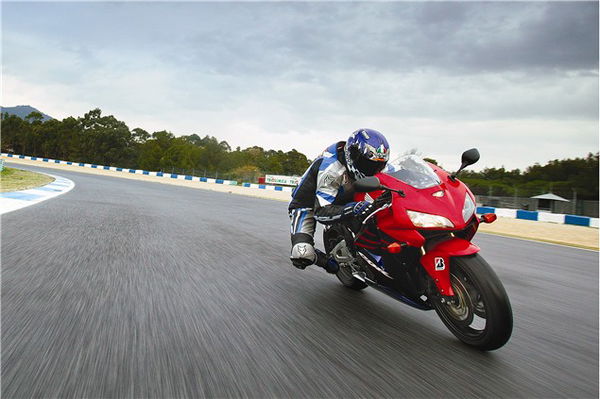First Ride: 2005 Honda CBR600RR
Two years on and the all-conquering CBR600RR gets its first major revamp. Has the best just got better? Crash test dummy Niall flies to Estoril to find out.

 |
It took just three laps of the Estoril GP circuit in Portugal to tarnish my four-year record of never crashing on a new bike launch. And the clues were staring me right in the face because I had seen World Champ Karl Muggeridge have a front end moment on the wet track for no apparent reason just a few corners before. I wasn't proud, although I must admit it was still kind of exciting in a sadistic, if painless sort of way.
So a bad start to the day but things did get much better as I gradually acquainted myself with the new, lighter and torquier 2005 CBR600RR.
When the original RR was launched in December 2002 I felt it set new standards in the middleweight class, giving us a one-size fits-all 250cc GP-like bike with the lightweight handling to match and a screaming motor.
I would have thought a few minor tweaks would have been enough to keep Honda's CBR customers happy. But the competition has raised its game recently, so the factory has pulled out all the stops in an attempt to reassert themselves as the manufacturer with the best supersports bike for the road and the racetrack.
The lack of mid-range punch was always evident when comparing the current CBR with the competition, but saving weight and increasing torque have gone hand-in-hand in addressing the problem.
Honda claim their all-conquering supersports machine has changed by 40%. When you look closely - and you do have to look closely, because many of the changes are subtle - you'll notice the new front mudguard, fairing and seat unit giving a sleeker appearance while helping ram air induction and saving on power-sapping weight.
The mods are instantly apparent. Just riding down Estoril's pit lane I could tell the engine had lost its lethargic feel, gained a mid-range surge and acquired a raspier exhaust note. Although the track stayed damp for most of the sessions, riding the little Honda is now more enjoyable as short shifting through the lower gears works well, whereas before you would have to ring its neck all the way through the box to maintain optimum acceleration. The wide spread of power is nicely complemented with silky fuel injection allowing smooth, predictable throttle control out of turns. Acceleration is also noticeably better in first to third gears - and so it should be, as more than 6kg has been trimmed off the CBR, bringing it in line with the competition at a claimed 163kg dry.
Thinner section walls on the still rigid frame have also helped significantly and, with Honda's emphasis on 'mass centralisation', many components, including the rider, are brought as close as possible to the machine's central turning axis. The tail unit is slimmer, the underseat exhaust is redesigned plus the lighter muffler helps direction change, all resulting in more agile handling.
Stability through the high-speed sections of the track inspires confidence, while the pin-sharp steering made lining up fast corners effortless and safe. A lighter swingarm now incorporates the upper shock mount, replacing the previous bolt-in unit, and the clever self-contained (but difficult for me to figure out) Unit Pro Link rear suspension system remains the same, giving great feedback at all times.
Our launch bikes were fitted with the brilliant BT014 Bridgestones, although 50% of the UK bikes may also come with the new 218 Dunlops. Earlier in the year I did a mass bike test on the Bridgestones at Almeria and found them to be an excellent tyre for grip and endurance. The Bridgestone technicians reduced tyre pressures for slick conditions at Estoril, but the grip problem I encountered shortly before sliding down the track on my backside was more down to the track surface rather than tyre performance.
With a dry line appearing I was able to push harder through the twistier sections of Estoril, and for sure the new CBR does feel lighter and more agile, though a back-to-back test would be the only real proof. A test is not needed, however, for the new upside down 41mm forks and radial mounted brakes, as they are both unquestionably more efficient and better looking to boot. The two-piece calipers and 310mm discs provide a powerful combination which need to be treated with the utmost respect in the wet - as I found out on those opening few laps. From the moment you touch the lever the brakes are progressive, strong and consistent. The new suspension also gives a higher static seat height, which Honda claims assists ground clearance.
The best looking and most ergonomic supersports dash remains unchanged, while hazard warning lights have been added to the right-hand switch gear. They even managed to come on during my crash, just to add to the embarrassment.
Honda also produces a range of extras and accessories, from a carbon tank pad to a data logger, and there is even an HRC race kit if you fancy being the new Karl Harris/Muggeridge. Finally, there are three new colour variations: the tri-colour red, silver and blue option, a simple candy blue and my favourite, black and silver.
As Honda says, the CBR gets its DNA from the superb RC211V MotoGP machine, both in looks and technology, and who could argue? But, like I said two years ago at the current RR's launch, I'd compare it more to Kylie - compact, perfect curves and bursting with talent. She's been mightily impressive over the last two seasons and now, with a thorough makeover, it's going to take something special to knock her off that pedestal.
VERDICT
With minor niggles addressed, the new CBR is a sound improvement on an already stunning package. More success beckons
SPECS
TYPE - SUPERSPORT
PRODUCTION DATE - 2005
PRICE NEW - £7299
ENGINE CAPACITY - 599cc
POWER - 102.2bhp@13,500rpm
TORQUE - 41.9lb.ft@10,900rpm
WEIGHT - 163kg
SEAT HEIGHT - 820mm
FUEL CAPACITY - 18L
TOP SPEED - 159.8mph
0-60 - n/a
TANK RANGE - 125MILES

It took just three laps of the Estoril GP circuit in Portugal to tarnish my four-year record of never crashing on a new bike launch. And the clues were staring me right in the face because I had seen World Champ Karl Muggeridge have a front end moment on the wet track for no apparent reason just a few corners before. I wasn't proud, although I must admit it was still kind of exciting in a sadistic, if painless sort of way.
So a bad start to the day but things did get much better as I gradually acquainted myself with the new, lighter and torquier 2005 CBR600RR.
When the original RR was launched in December 2002 I felt it set new standards in the middleweight class, giving us a one-size fits-all 250cc GP-like bike with the lightweight handling to match and a screaming motor.
I would have thought a few minor tweaks would have been enough to keep Honda's CBR customers happy. But the competition has raised its game recently, so the factory has pulled out all the stops in an attempt to reassert themselves as the manufacturer with the best supersports bike for the road and the racetrack.
The lack of mid-range punch was always evident when comparing the current CBR with the competition, but saving weight and increasing torque have gone hand-in-hand in addressing the problem.
Honda claim their all-conquering supersports machine has changed by 40%. When you look closely - and you do have to look closely, because many of the changes are subtle - you'll notice the new front mudguard, fairing and seat unit giving a sleeker appearance while helping ram air induction and saving on power-sapping weight.
The mods are instantly apparent. Just riding down Estoril's pit lane I could tell the engine had lost its lethargic feel, gained a mid-range surge and acquired a raspier exhaust note. Although the track stayed damp for most of the sessions, riding the little Honda is now more enjoyable as short shifting through the lower gears works well, whereas before you would have to ring its neck all the way through the box to maintain optimum acceleration. The wide spread of power is nicely complemented with silky fuel injection allowing smooth, predictable throttle control out of turns. Acceleration is also noticeably better in first to third gears - and so it should be, as more than 6kg has been trimmed off the CBR, bringing it in line with the competition at a claimed 163kg dry.
Thinner section walls on the still rigid frame have also helped significantly and, with Honda's emphasis on 'mass centralisation', many components, including the rider, are brought as close as possible to the machine's central turning axis. The tail unit is slimmer, the underseat exhaust is redesigned plus the lighter muffler helps direction change, all resulting in more agile handling.
Stability through the high-speed sections of the track inspires confidence, while the pin-sharp steering made lining up fast corners effortless and safe. A lighter swingarm now incorporates the upper shock mount, replacing the previous bolt-in unit, and the clever self-contained (but difficult for me to figure out) Unit Pro Link rear suspension system remains the same, giving great feedback at all times.











